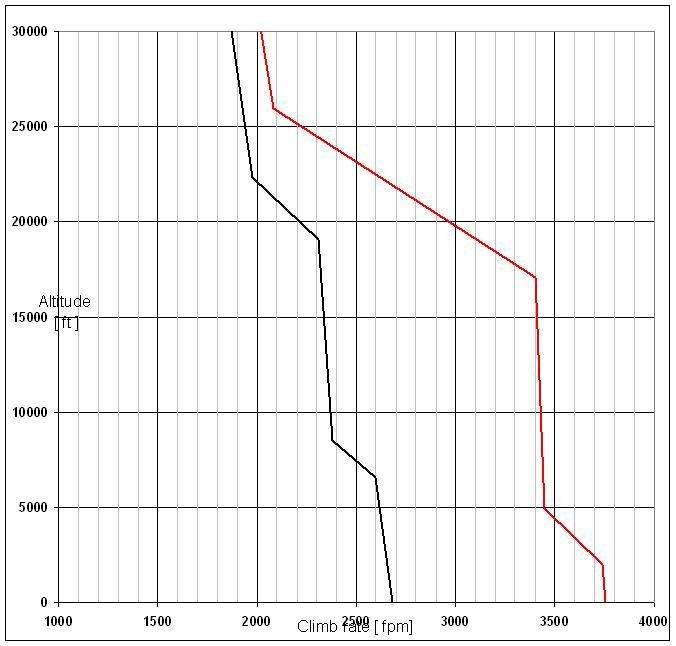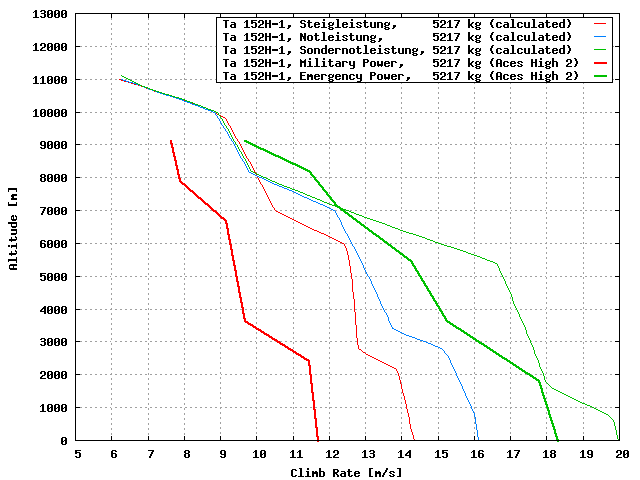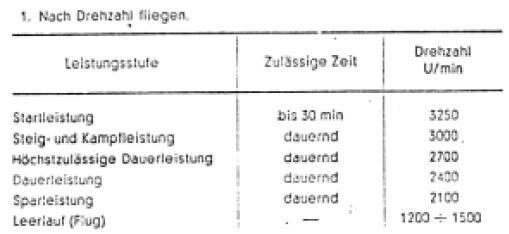I have been trying to calculate the climb rate of the Ta-152H-1.
First the climb rates in AH2, that are supposedly generated by the game engine:

The calculation used the following datasheets:
Manufacturer drag data. Cd0 (climb) and the Oswald efficiency factor ( e ) were obtained here:
http://img.photobucket.com/albums/v424/timppa/FW190_Ta152_drag.jpgJumo 213E engine chart:
http://img.photobucket.com/albums/v424/timppa/Jumo213E-performance_chart.pngExhaust thrust chart:
http://img.photobucket.com/albums/v424/timppa/abgasschub_Jumo213E.gifMy calculation was somewhat simplified, it did not take into account:
- Ram effect
- Climb speed is calculated with constant EAS, not optimum at each altitude
- Possible propeller efficiency drop due to Mach-induced tip losses.
- Kinetic energy correction, as the TAS is slowly increasing with altitude.
The calculation was done using the same weight ( 11,501 lb = 5,217 kg) so that the AH2 curves and the calculation can be compared directly:
My results from the calculation:
Weight,W: 5216.6 kg
11501 lb
Wing Area, S: 23.3 m2
Wing Span, b: 14.44 m
Prop Diameter, D: 3.6 m
Parasitic drag coefficient, Cdp: 0.029
Aspect ratio, AR: 8.949
Oswald efficiency factor, e: 0.727
Prop. efficiency correction, Pcorr: 0.8587
Altitude: 0 m
0 ft
Temperature,T: 288.2 K
Density, rho: 1.225 kg/m3
Power at altitude, Pmilitary: 1580 PS
1558 hp
1162 kW
Exhaust thrust; TEmil: 960 N
Climb speed: 69.5 m/s
250 km/h
155 mph
Propeller efficiency a: 7.198901785
eta: 0.899053658
Propeller efficiency: 0.77
Total thrust: 13872 N
Parasitic drag, Dp: 2012 N
Induced drag, Di: 1860 N
Climb rate: 13.6 m/s
2673 fpm
This procedure was repeated at each altitude, with both Climb and Special Emergency -power. The graphical result is as follows:

As a comparison, our old forum member Hohun calculated it also with his own spreadsheet , taking account of the ram effect, tip losses, and with optimal climb speed (compared also with AH2 curves):

Note that the blue line represents Start/Not -leistung, which ( according to the pilot handbook ) was cleared for 30min duration. IMO it would be more representative to use it as MIL -power in AH2. Btw. the same applies to the Fw190D-9 as well:

Conclusions:
AH climb curves are quite a lot different from the calculated ones . Not only by magnitude, but by shape as well. For example there seems to be emergency power enabled in the third supercharger gear also, which does not correlate with the posted engine chart. I can only think that HTC have used different engine data.
The climb rate, especially at military power is significantly lower than it should be (by calculation).